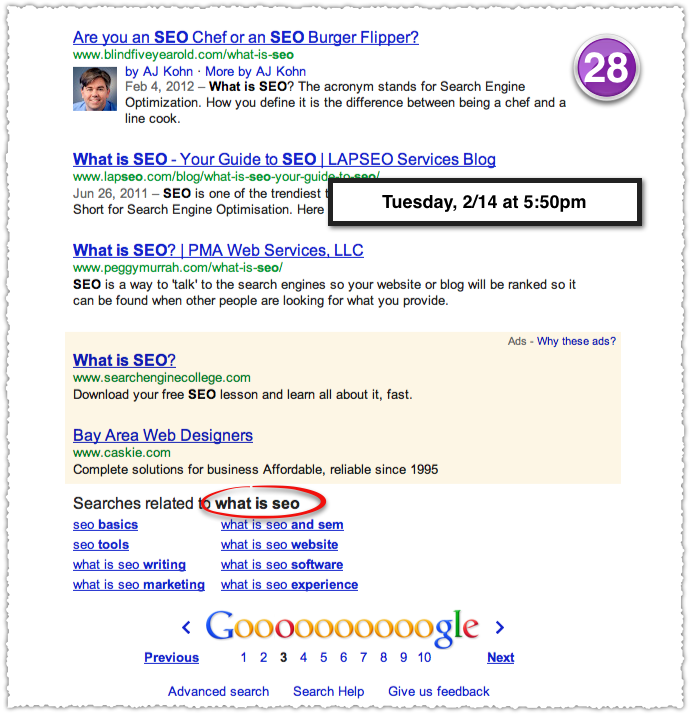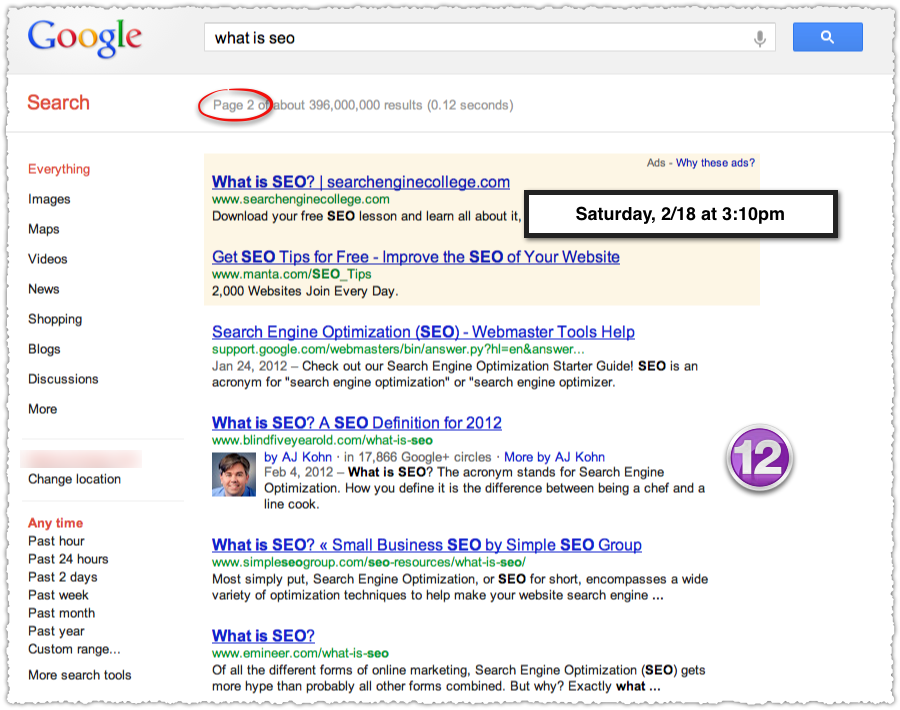One of the things I’ve learned blogging is that a blog post can have two distinct lives. Upon hitting the publish button a blog post lives in the sparkly social spotlight. But soon the lights fade and the crowd goes home. It’s time for that blog post to start working a 9 to 5 job, bringing traffic to your site each and every week.

Optimizing your posts for both of these lives is important but takes some foresight. Here’s how I do it.
The Social Life
The social life of a blog post is short, lasting between 48 hours and two weeks if you’re lucky. Your goal is to generate social proof for that post. You want the post to be the life of the party, the one people are talking about, sharing and discussing.
One of the best ways to do this is to optimize your social snippet with a snappy Title. This is not the Title you’ll use long-term but should be the one that you think is going to get some attention in your industry.
For my ‘What is SEO?‘ post I went with ‘Are you an SEO Chef or an SEO Burger Flipper?’ Actually, this is a slightly modified version that I quickly adopted after seeing a Tweet by Cyrus Shepard. (Thanks again Cyrus.)
Clearly I am not trying to rank for the term SEO Chef! I ultimately want to rank for ‘What is SEO?’. But I’d weaved the cooking concept into the post and the Title seemed provocative enough to generate some added buzz.
So how did I do at generating social proof for this post?

Not bad. I was hoping for more but I can’t really complain about these numbers.
The 9 to 5 Life
Fast forward 10 days and the social life of this post had essentially run its course. It was time to get serious and see if I could rank well for the term ‘What is SEO?’. Before I change the Title on the post I check to see where it is ranking for the term.

28 isn’t that bad.
I change the Title of this post so it’s appropriately targeted for ‘What is SEO?’ and then use Google Webmaster Tools to ask Google to crawl the page again.
Four days later I see that Google has acknowledged the change and the post is now ranking differently for the term ‘What is SEO?’.

So without doing anything else other than changing the Title of the post I was able to rise 16 spots for a fairly competitive term. If you’re not paying attention, let me put it another way, the power of the Title tag should not be underestimated.
It would have been nice if this had landed on the first page but sometimes things don’t go exactly as planned. And I’ve since dropped to 15th for this term because I haven’t done any link building, both internal or external, to help it get to the first page. (Should you want to help here please go ahead!)
Life Synergy
It sounds like some sort of new-age cult but I firmly believe that part of the reason the post ranks as well as it does is because of the successful social life of that post. There is a synergy between the social life and the 9 to 5 life. The better social life you have, the better chances that post will have a productive 9 to 5 life.
This isn’t even about whether social signals are being used in the algorithm. Social proof creates a social echo that translates into links.
It’s not the links on Twitter or any other platform that count. It’s the links you get because of that additional exposure. It’s the person who sees your post shared on Google+ and then decides they’ll link to it in their own blog post.
Title Mechanics
I find that there’s often some confusion over what can and should be changed, so I’m going to review the actual mechanics around this type of blog post optimization.
Ensure that your URL is targeted for the 9 to 5 job.

You do not want to change this so get it right from the start.
The title of the blog post matches the URL in this instance. It doesn’t have to. I could change that to ‘The Definition of SEO’ and keep the URL the same. WordPress will seek to match these two but you are in control. Click edit and optimize your URL.
The title of the blog post is different than the Title tag for the post. As I’ve shown, the Title tag is really important.

This is what will be used in your social snippets and will show up as that big blue link on Google search results. I use All in One SEO but you can do the same type of optimization using Yoast’s SEO Plugin or SEO Ultimate. The point is to actually do it!
This type of blog optimization works best when you’ve got it planned out in advance. If you haven’t you can still go back and use SEO Judo to retarget older posts.
TL;DR
The social life of a blog post can have a profound impact on its ability to rank well and drive long-term traffic. Use the Title tag to generate social proof and then change it to match and rank for your long-term keyword goals.
The Next Post: No Such Thing As A Good Scraper
The Previous Post: Bing Linked Pages

4 trackbacks/pingbacks
Comments About Blog Post Optimization
// 17 comments so far.
Adam // March 13th 2012
Interesting, I never thought of changing the Title after it hast cooled off. I’ll have to go and tweak some titles.
AJ Kohn // March 13th 2012
Thanks for the comment Adam. Definitely go back and see how that post is doing after the social life has worn off. Tweaking the Title can help draw additional search traffic in the long-term and helps to better match that content with query intent. I sometimes look at posts from two years ago, tweak the Title and suddenly get a new set of eyes on that content.
Adam // March 13th 2012
I would have to open up the comments on those posts. I have been closing the comments after 90 days I believe. What are your thoughts on closing comments?
AJ Kohn // March 13th 2012
I keep comments open on all my posts. I get a ton of spam but I figure that the ability to engage is more important in the long-run. In fact, sometimes a comment on an old post will trigger the type of review I’m talking about. You look at the post again and it needs to be updated (both in content and in formatting) and then you’re looking at the Title and massaging it.
Comments help keep me honest and force me to review aging content. Both good things in my book.
Aaron // March 14th 2012
Hey AJ,
I think this is a great idea. But what if your posts are a little more evergreen (like this one)? It would seem to me that you can very easily recycle them through the social media process at least once a month and get more mileage out of them.
Do you still think it would benefit from updating titles for SEO? I guess it probably just depends on your strategy.
Kristinn // March 15th 2012
This is a really nice post. You can continue to work on a single post this way and keep making it better and better. Then at some point it will become (hopefully) a profitable landing page. You mentioned that you go to Webmaster Tools and ask G to re-crawl. Doesn’t WordPress xml sitemap addin automatic submission trigger a re-crawl? That is what I rely on, but I’m not sure that it does.
Cheers,
Kris
AJ Kohn // March 15th 2012
Kristinn,
Thanks for your comment. You’re right, you can keep making the Title and the content better and better over time. The biggest issue is remembering to go back and check-in on that content from time to time.
I’m not sure that updating a post would automatically trigger a crawl. Frankly, you probably don’t even have to worry about it that much if you’re not in a rush. After Google launched Caffeine most of those issues have gone away. I simply used the new GWT functionality to see how quickly I could get it to change. Frankly, I wasn’t that impressed. I think it would have been about the same if I hadn’t done that.
Herner // March 18th 2012
AJ I am a long time reader first time poster. I am no SEO guru but I do try and dabble and am a long time Seomoz Member.
Just wanted to say I liked this concept very simple. I took an old article that was ranking #19 and added
1) a link to a wiki page on the topic as ‘background’ for people to do some more reading after they finished my piece.
2) I added a proper excerpt and modified the content ( added a bit more, made better use of my focus word )
I submitted to google and got recrawled and I have come up 2 rankings in 1 day to #17. The real test will be what does it look like tomorrow. Fluke or progress? I dont know. Great article!
AJ Kohn // March 18th 2012
Herner,
Thanks for the comment and for sharing your experiment. I really like that you added a link to a wiki page. Providing related and valuable links is a positive signal in my opinion. If you change the Title you’ll really know when Google processes the change. So keep an eye on things and let us know how it turns out.
Herner // March 18th 2012
The only reason I did not change the title was because it was hard to justify. I did not want my first comment to contain a link since its whorish but let me give you the link and my thought process.
The target is ‘monster movies’ and the page is; http://www.horror-movies.ca/2012/02/top-10-modern-monster-movies/
The title is unchanged the content I expanded upon as noted, making it better. I am curious can you elaborate on the title change? How will the title change really show me the difference? Doesnt what I have done now do that? Or do you think with a more targetted title I can shoot further up.
Cheers enjoying the dialogue.
AJ Kohn // March 18th 2012
The Title change will enable you to determine when Google reassesses because you’ll see the Title change in search results. Without changing the Title you’re a bit in the dark as to the true time frame.
You could make an easy change like ‘The Top 10 Modern Monster Movies – HorrorMovies.ca’ or you could do something more radical like ‘Monster Movies: The 10 Best Modern Monster Movies’. Personally, I’m not sure the domain at the end is helping you much.
Either way, the goal is to make some sort of change to the Title so you can measure when Google really processes the changes to your post.
Herner // March 18th 2012
AJ… in a word I overlooked the trees for the forest. My complaint of not knowing if it was fluke or alterations would CLEARLY have been answered by your advice of a title change.
I am doing that now and noting it. I will let you know what ranking impact I see.
Herner // March 19th 2012
As a followup was just looking and since the tweak I am up two more positions to #15. Of course my biggest issue with checking rankings is so many rankings are now personalized by user.
AJ Kohn // March 20th 2012
Herner,
Yes, I see you there at #15 for ‘monster movies’ in Chrome Incognito. So from #19 to #15 in a few days. Not bad at all. Just have to get yourself up to that first page.
Be sure to implement Authorship if you can. It won’t change your ranking (right now) but it could help increase CTR when you do crack the top 10.
Herner // March 25th 2012
Aj after giving it a few days and looking with google incognito I have landed at #11 and seem to be staying there. interesting experiment. Unfortunately no increase in traffic to the page but still a nifty experiment.
AJ Kohn // March 25th 2012
Thanks for the update Herner. 11th is so close yet so far. The improvement in rank is great but you’ll need to find your way to the first page to see any appreciable gains in traffic. A few more links (both internal and external) might get you there.
Herner // March 25th 2012
It is definitely a really fun experiment. I just ran a similar experiment which is one that I might regret. I recently switched from a custom CMS to a popular open source one.
In doing so my old cms content is sitting lonely and un-editable. Last night I just ported an old article that had a ton of social likes, and has aged for some time to a new url in the NEW cms.
Old URL:
http://www.horror-movies.ca/horror_18308.html
New URL:
http://www.horror-movies.ca/21-best-horror-movies/
I just did it yesterday so today I will be asking google for a recrawl of the old one which is a 301. The new page has the following benefits over the old one;
– opengraph data
– a better evergreen url
– other backend code advantages.
It will be curious to see what happens. This is a prelude to me doing a complete domain name change which I have been putting off for 3 years out of fear of losing position.
Sorry, comments for this entry are closed at this time.
You can follow any responses to this entry via its RSS comments feed.